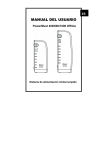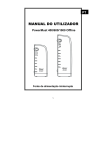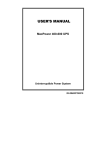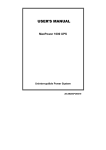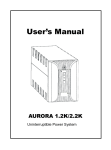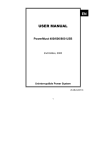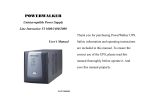Download Mustek Power Must 400 User`s manual
Transcript
GB USER’S MANUAL PowerMust 400/600/1000 Offline Uninterruptible Power System 28-2MAXPO00201 IMPORTANT SAFETY INSTRUCTIONS SAVE THESE INSTRUCTIONS – This manual contains important instructions for models PowerMust 400 Offline, PowerMust 600 Offline, and PowerMust 1000 Offline that should be followed during installation and maintenance of the UPS and batteries. Safety – CAUTION! This product is specially designed for PCs and it is not recommended for use in any life-supporting system and other specific important equipment. CAUTION: Risk of electric shock, do not remove cover. No user serviceable parts inside. Refer servicing to qualified service personnel. Connection to any other type of receptacle other than a two-pole, three-wire grounded receptacle may result in shock hazard as well as violate local electrical codes. In the event of an emergency, press the OFF button and disconnect the power cord from the AC power supply to properly disable the UPS. Do not allow liquids or any foreign object to enter the UPS. Do not place beverages or any other liquid-containing vessels on or near the unit. This unit intended for installation in a controlled environment (temperature controlled, indoor area free of conductive contaminants). Avoid installing the UPS in locations where there is standing or running water, or excessive humidity. Do not plug the UPS input into its own output. Do not attach a power strip or surge suppressor to the UPS. Do not attach non-computer-related items, such as medical equipment, life-support equipment, microwave ovens, or vacuum cleaners to UPS To reduce the risk of overheating the UPS, do not cover the UPS’ cooling vents and avoid exposing the unit to direct sunlight or installing the unit near heat emitting appliances such as heaters or furnaces. Unplug the UPS prior to cleaning and do not use liquid or spray detergent. Do not dispose of batteries in a fire as they may explode. Do not open or mutilate the battery or batteries. Released electrolyte is harmful to the skin and eyes. It may be toxic. A battery can present a risk of electrical shock and high short circuit current. The following precautions should be observed when working on batteries: 1) Remove watches, rings, or other metal objects from the hands. 2) Use tools with insulated handles. 3) Wear rubber gloves and boots. 4) Do not lay tools or metal parts on top of batteries. 5) Disconnect charging source prior to connecting or disconnecting battery terminals. Servicing of batteries should be performed or supervised by personnel knowledgeable of batteries and the required precautions. Keep unauthorized personnel away from batteries. When replacing batteries, replace with the same number and type of sealed lead-acid battery. This pluggable type A equipment with battery already installed by the supplier is operator installable and may be operated by laymen. During the installation of this equipment it should be assured that the sum of the leakage currents of the UPS and the connected loads does not exceed 3.5mA Attention, hazardous through electric shock. Also with disconnection of this unit from the mains, hazardous voltage still may be accessible through supply from battery. The battery supply should be therefore disconnected in the plus and minus pole at the connectors of the battery when maintenance or service work inside the UPS is necessary. The mains socket outlet that supplies the UPS shall be installed near the UPS and shall be easily accessible. Φ on the rating label stands for phase symbol. WARNING: This is a UPS Class C2. In residential subdivision the product may cause harmful interference, then the users have to take additional measures.” 1. System Description Front panel: 1. Power Switch 3. Fault LED: Red flashing 2. UPS status Indicator – AC Mode: Green lighting Battery Mode: Green flashing 400/600 Back Panel 1. Output receptacles 2. Fuse 400/600 1000 3. Modem/Phone Line Surge (Protection Function) 4. AC Input 1000 2. Installation and operation 1. Inspection Remove the UPS from its packaging and inspect it for damage that may have occurred during shipping. If any damage is discovered, repack the unit and return it to the place of purchase. 2. Charging This unit is shipped from the factory with its internal battery fully charged, however, some charge may be lost during shipping and the battery should be recharged prior to use. Plug the unit into an appropriate power supply then switch ON the UPS and allow the UPS to charge fully by leaving it plugged in for at least 10 hours with no load (no electrical devices such as computers, monitors, etc.) connected 3. Placement Install the UPS unit in a protected environment that provides adequate airflow around the unit, and is free from excessive dust, corrosive fumes and conductive contaminants. Do not operate your UPS in an environment where the ambient temperature or humidity is high. 4. Computer Connection Plug the UPS into a 2-pole, 3-wire grounded receptacle. Then connect one computer-related device into each of the power receptacles supplied on the back of the UPS. 5. Modem/Phone Line Connection Plug incoming Modem/Phone line into the “In” socket at the back of the UPS. Use another cable and plug one end to the “Out” socket at the back of the UPS. Plug the other end to the modem input socket as shown. Incoming Modem/Phone Line 5. Turn On/Off Press the switch of the UPS continuously for 1 second and the UPS turns into its normal state (the green light is on and the beeper is off) after it performs a self-diagnosis (the beeper and the red and green indicator lights are on) for several seconds. At this time, user may turn on the PC and other loads. Press the switch of the UPS continuously for 1 second to turn off the UPS. Note: 1. For the convenience of maintenance, please turn on the UPS first before turning on the PC and the other loads, and turn off the UPS after the loads are turned off. 2. At ordinary times, we recommend to remain the UPS on with the battery charging (even if the loads are turned off), which is benefit to the maintenance of the battery. 3. Trouble Shooting Symptom Possible Cause No LED display 1. Battery Weak on the front panel. 2. Battery defect. 3. Power switch is not pressed. 4. Battery connector loosed Remedy 1. Re-charge battery up to 8 hours. 2. Replace with the same type of battery. 3. Press power switch again. 4. Check the internal battery connection When power 1. Overload of the UPS. 1. Remove some non-critical failure, backup load. time is short. 2. Battery voltage is too low. 2. Charge battery 8 hours or more. 3. Battery defect due to high 3. Replace with the same temperature operation type of battery. environment, or improper operation to battery. Mains normal 1. Fuse is blown. 1. Replace the same type of but LED is fuse. flashing. 2. Power cord is loose. 2. Reconnect the power cord properly. If any abnormal situations occur that are not listed above, please call service people immediately. 4. Specification PowerMust 400 PowerMust 600 Offline Offline MODEL CAPACITY VA/W INPUT Voltage OUTPUT Voltage 400VA/200W 600VA/300W 110/120VAC Voltage Range 90-145VAC / ±10% 50Hz or 60Hz Frequency Regulation (Batt. Mode) +/-1 Hz Output Waveform (Batt. Mode) Modified Sinewave Battery Type & Number 12V/4.5Ah x 1pc 12V/7AH x 1pc 12V/7AH x 2pc 13 minutes 30minutes(typical) Back up Time (at a PC load with 15" monitor) Recharge Time 6 minutes 10 hours to 90% after complete discharge Typical AC Mode Battery Mode Low Battery at Battery Mode 2-6ms, 12ms max Green LED lighting Green LED flashing every 4 seconds Green LED flashing every second Fault INDICATOR AUDIBLE ALARM 170-280VAC 220/230/240VAC Frequency TRANSFER TIME 1000VA/600W 220/230/240VAC 110/120VAC Voltage Regulation (Batt. Mode) BATTERY PowerMust 1000 Offline Red LED lighting Battery Weak at AC Mode Red LED flashing every 2 seconds for 30 seconds Battery Fault at AC Mode Red LED flashing three times every 2 seconds Red LED flashing twice every second Overload N/A Battery Mode Sounding every 4 seconds Low Battery at Battery Mode Sounding every second Fault Continuously sounding Battery Weak at AC Mode Sounding every 2 seconds for 30 seconds Battery Fault at AC Mode Sounding three times every 2 seconds Overload N/A Sounding twice every second PROTECTION Full Protection PHYSICAL Dimension, DXWXH (mm) Net Weight (kgs) ENVIRONMENT Operating Environment Noise Level Discharge, overcharge, overload*(only for 1000VA) 213x75x185 2.5 281.4x84x240.5 3.1 6.5 0- 40°C, 0-90 % relative humidity (non-condensing) Less than 45dB











